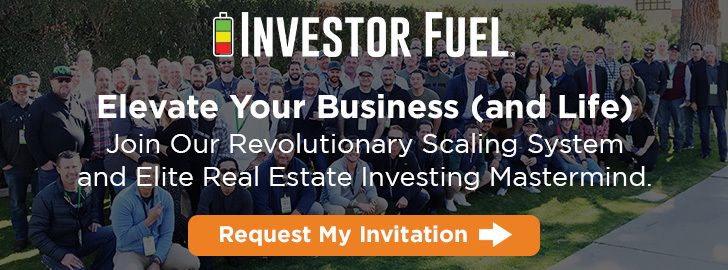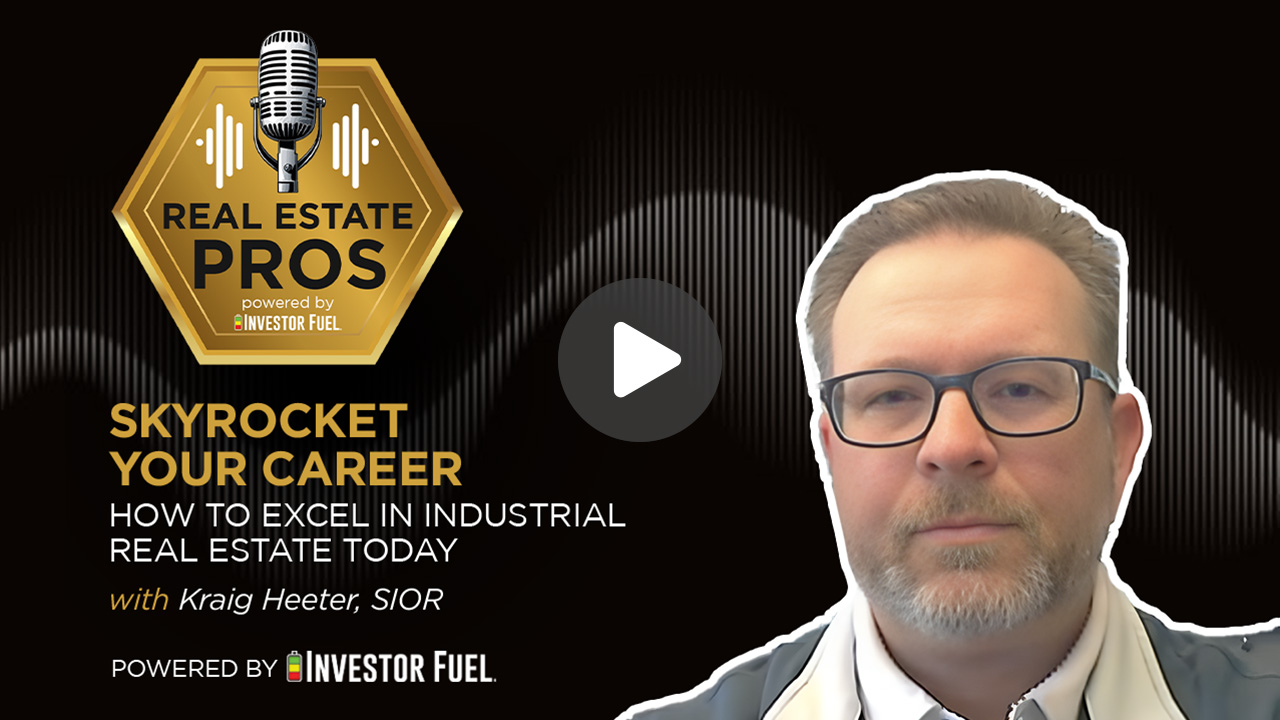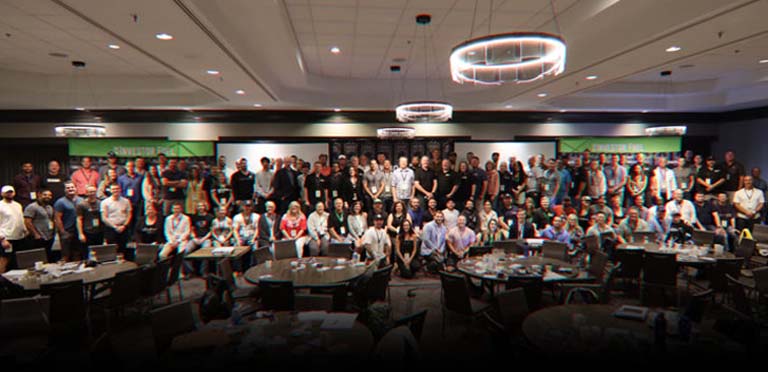
Show Summary
In this episode, Stephen S. interviews Kraig Heeter, a seasoned professional in industrial real estate. Kraig shares his unique journey from being a professional golfer to becoming a successful broker and investor in the industrial sector. He discusses the importance of distribution space in the real estate market, the keys to success in the industry, and his approach to building trust with clients. Kraig also reflects on his career choices and the lessons learned along the way, emphasizing the significance of perseverance and long-term thinking in achieving success.
Resources and Links from this show:
Listen to the Audio Version of this Episode
Investor Fuel Show Transcript:
Stephen S. (00:03.84)
Welcome to the show where we interviewed the nation’s leading real estate entrepreneurs. Welcome to and welcome back to the real estate pros podcast. I am here today with Kraig Heeter. And today we are going to be talking about industrial real estate. Kraig is a long term professional here in the real estate business who does focus on industrial and commercial properties. He’s got a wealth of knowledge that he is going to be sharing today. And just remember at Investor Fuel,
We help real estate investors, service providers, and real estate entrepreneurs 2 to 5X their businesses to allow them to build the businesses they’ve always wanted and allow them to live the lives they’ve always dreamed of. With all that being said, Kraig, we’re super excited to have you on the show. Thanks for being here today.
Kraig Heeter, SIOR (00:46.646)
Yeah, thanks for having me, Steven. I look forward to this opportunity. I love talking any and all things industrial real estate. mostly I’m talking about most of the demand in the United States and in my market in the greater Seattle area or West Coast is distribution space. So warehousing space. And, you know, there is a manufacturing component as well. But most of I think anybody that talks about industrial real estate is mostly talking about distribution space.
Stephen S. (01:17.47)
distribution space. Well, I’d like to get into that and learn a little bit more about what you mean by that. But before we do that, give these folks just like a little bit more about you, what got you started into real estate, how you ended up and what you’re doing now. Tell us a little bit about that journey.
Kraig Heeter, SIOR (01:34.444)
Yeah, well, it kind of started when I was playing, I was a professional touring golfer. was playing mini tours all over North America and I was down in Florida. I was married at the time too. I got married in college to my, my then high school sweetheart and now we’ve been married 26 years, but I was down in Florida playing golf tournament and realized that’s not what God had.
in mind for me for the rest of my life. So literally since I was 12 years old, I wanted to be a professional golfer. And I, on my way home, driving back from Florida, from Orlando to Seattle, I said, my gosh, what am I going to do for a living? And basically I worked with my network, my limited network that I had to get some meetings.
I cold called a managing director by the name of Jim Bowles, who was managing the CB Richard Ellis’s office in Seattle at the time. And I called him every day for about four months until he gave me a job. And I worked my way from the bottom in what we called back then the data bank or research position. And then I became a broker in about 2003. So here I am 22 years.
In the business, I moved to Kidder Matthews six years after I started. I’ve been at Kidder Matthews, where West Coast Boutique privately owned, a full service commercial real estate firm. We’ve got 22 offices and I’ve been here since 2007. became a partner in 2016 and absolutely love what I do. I mostly spend my time working with tenants and landlords and the leasing and sales of industrial properties.
So we’re talking anything with a dock door, a large grade level door, or that has significant power for manufacturing. That’s my bread and butter. And I absolutely love it.
Stephen S. (03:37.024)
Wow, man, that’s so awesome. I learned none of that in our previous talk before we started recording. So that is super, super interesting. So you were a touring golfer that and what was that transition like when you’re on tour living out the dream that you had as a kid and then just like, did you just wake up one day and it was like, I’m not supposed to do this anymore. What was that like? Was there like a specific experience or moment where you’re like, I gotta, I gotta do something different.
Kraig Heeter, SIOR (03:37.774)
I don’t know.
Kraig Heeter, SIOR (04:05.678)
There was, yes, definitely a specific experience. you know, I was a late bloomer in golf. You know, I was an average junior player, got a chance to play at a little school called Hillsdale College Division II, got better and better there. And then I just had the opportunity to go chase my dream. Looking back, I wasn’t good enough. But I quickly learned that, I mean,
There’s a big difference. Like we’re recording this the day after the Masters finished. Okay. So there’s this, there’s a significant difference between even when I was playing my best golf, I was like a plus four handicap and I don’t know the odds of getting there, but they’re extremely low. and, the guys, you know, Rory McRoy who won is probably a plus 10. So he would beat me at my very best at, you know, by six shots around. So,
Stephen S. (04:39.296)
Right.
Kraig Heeter, SIOR (05:03.032)
But I played at a high level one. It’s kind of a funny story. So I think it costs about $60,000 for me to chase my dream. This is back 20 plus years ago. And I think I made $6,000. So when you compare it, I played it like, if you compare it to baseball, because most people understand that, I probably played at the, the AA level when you really look at it. So I was a really good player.
but not nearly at the level to get there. And I quickly realized that I would have had to spend another 10 years to maybe get to that level. And like I said, I was married, my wife and I wanted to start a family young. And so I was down, I was playing the Canadian Tour Qualifying School in Orlando, Florida. I think I was in, if I remember correctly, it was five rounds. And after the third round, I was in the mix.
Stephen S. (05:43.552)
Hmm.
Kraig Heeter, SIOR (06:01.166)
on the border, the top 30 qualifying. And I woke up the fourth day, literally was an out of body experience. I couldn’t swing the club. was shanking the ball in the driving range. I think I got it out like a 78 and most people would be like, wow, 78 is really good, but not when everybody’s shooting 68. So I literally called my wife after that and it was literally a sign from God that I was not supposed to do this. I literally called my wife after, mind you,
Stephen S. (06:20.81)
you
Kraig Heeter, SIOR (06:30.574)
wanting to be a professional golfer my whole life. And it was a complete shock to her. said, Hey, I’m going to finish my obligation. I’m to play one more round and then I’m coming home and I’ll get a job. I didn’t know what that meant, but that was my story in the commercial real estate. my dad had a wealth, a small wealth management firm in Seattle. And I picked the brain of his broker that he’d used for 20 years who helped me get a meeting. And that’s how I got into the business. I,
I bumped along the bottom, gosh, probably five years as I didn’t really have a significant mentor. So I just made mistakes, kept grinding, kept grinding, kept showing up. And then organically, my business started to grow to what it is today.
Stephen S. (07:17.95)
Now, so this was all instigated, like you even finding out about this industry from having that conversation you said with your father’s broker at the time.
Kraig Heeter, SIOR (07:27.318)
Yeah, but I didn’t know anything about industrial real estate. You know, I knew a little about office probably just from my dad’s perspective and his business. But by no means did I know anything about industrial real estate. I, in fact, I was offered a job to work for a guy as he was an office tenor rep broker in downtown Seattle. And I’m not a huge fan of the city.
I I’d much rather, I like to hunt fish and get outside and get away, go to Eastern Washington and play. So I was not attracted to a downtown lifestyle where I’m in a parking garage in the concrete jungle. And when I got an opportunity to work in an office in Tuckawilla, Washington, just South of Seattle, where it was free parking, because I was broke, right? I didn’t have the $200 a month to pay for parking in a garage.
when it was free parking and when I didn’t have to work on the 20th floor of a high-rise, that was super attractive to me. And I learned the industrial real estate business kind of from the ground up.
Stephen S. (08:42.014)
Wow, that’s amazing. Yeah, because most people don’t just start with industrial real estate. There’s a story on usually how you get there. So that’s a really interesting origin. what does it take? you’re also, not just a broker, you also invest in yourself. So with that, what does it take to succeed in industrial compared to other…
forms of even commercial real estate or single family, et cetera, as an investor or an agent. What’s the differences there?
Kraig Heeter, SIOR (09:14.67)
Well, I think a lot of the top, I was going to say top deal makers, whatever you want to call them, best in class, everybody’s different, right? But I would say the people that are successful, whether it’s residential, if you’re being a top agent, if you’re a top office broker, you could look at and say there’s 10 qualities or so that make
person, if you’re really good at one or two, I think you can do very well. And those one or two things can be different for different people. You just have to leverage that. For instance, I quickly develop trust and relationships when I get a new client where I’m a valuable trusted advisor, I would say faster than most.
I also leverage my network too. So I’m constantly calling the people that I’ve done deals with or have relationships with asking for referral business. And when I get those, in fact, I just got one two weeks ago from a general contractor who owns some buildings. I’ve sold a couple of buildings for him and he, he called me and said, Hey, reach out to this person. We’ve known their family for 30 years. They have a building in Auburn.
Washington and they need a leasing broker. And I literally have instant credibility when I go and call that guy. And mind you, this guy’s hounded by brokers left and right on a weekly basis, always checking in because they own multiple buildings. And I went down, met him, had instant credibility because of my referral and got the business signed up. And it was funny, I recently put, it’s a 30,000 square foot building, industrial building.
And I got calls from three brokers in our market and they all said, how did you get that listing? I’ve been, I talked to that guy last week. And in every case, they were shocked that I was able to get the business because they felt like, you know, they’ve been calling this guy for 10 plus years thinking that they would get an opportunity. And I was able to go in there based on my reputation from the referring party and win that business. So.
Kraig Heeter, SIOR (11:38.264)
That’s kind of how I think you got to be good at a couple things, whether, you know, no matter what your specialty is, and if you leverage that, then you can do very well.
Stephen S. (11:49.48)
Wow. What do you think is it about you that you you mentioned something there about how people tend to trust you faster or trust you fast just in general. Why do you think that is? What do you think it is about you that exudes trust in others?
Kraig Heeter, SIOR (12:05.9)
Well, I’m transparent. So, you know, I’ll give the good and the bad. You know, I also have no problems saying, even though I’m in hundred percent commission business where I only get paid when I perform, whether a sale closes or a lease gets signed, I say no often. I’ll tell a client, I wouldn’t do this deal for whatever reason. If there’s a concern about credit of the tenant, if their use is a concern,
Stephen S. (12:07.882)
Hmm.
Kraig Heeter, SIOR (12:35.522)
something like that because in the industrial world, there’s all kinds of different types of use. And say for instance, there’s a heavy trucking use on a building, an older building that can beat the hell out of the building and really impact its value. you know, when I say, when I tell a client, no, I wouldn’t do that deal, they know that, holy crap, know, Kraig only gets paid when he does a deal. So he’s really looking out for me and my family.
And so little things like that really help. And then when the right deal comes along, I can usually help them with education on all kinds of different variables that, this is our right deal. Let’s grab this one. Let’s be a dog and a bone and get it done. So those are, I would say from that aspect, you gotta be completely transparent and not have
what I’d call commission breath, right? So, because people can smell commission breath from a mile away if you’re trying to just get a deal done. And that’s what I try to avoid.
Stephen S. (13:43.05)
So do you think that comes from a genuine care of serving your clients? Do think that’s where that ultimately comes from?
Kraig Heeter, SIOR (13:50.126)
Well, I’ve always taken the approach that I’m going to be in this business for a long time and it’s a marathon, not a sprint. So I’ve always tried to look at the long game. and when you look at deals from a long game, it may hurt you in the short run, but, I can tell you that, that over time is just built. It’s just built and my business continues to grow organically.
And it’s probably because of that long-term view that I’ve been willing to take.
Stephen S. (14:24.608)
Absolutely. Now let’s kind of go back to another topic that you had started to touch on and then we got through an intro and have kind of gotten off in the weeds here now. But you mentioned the distribution space earlier on the show. Tell us a little bit more about that.
Kraig Heeter, SIOR (14:39.662)
Well, you know, I would say most of the products that show up at people’s houses come from somewhere. So, and a lot of it comes from overseas, whether you’re buying from Amazon or there’s parts for a certain thing that maybe gets assembled here in the U.S. but the parts are from from overseas. And these parts come in usually via ship, you know, from let’s say, let’s just in a general term, say Asia, because that’s where a bulk of the
the parts and materials come from and they’re going to come off the ports and containers and then move to a warehouse Usually in a port city. We have the port of Tacoma, which is a large western United States port and Then they go to a warehouse get broken up and then shipped whether it’s by rail or usually by truck these days to other parts of the country and So it all starts
through this distribution or transportation program. And then when it say goes to Chicago, it’s going to get broken up there even more and go to stores, stores or households, whatever it may be. you know, if most people don’t look around and see that vast distribution network that the United States has, but big port cities like Seattle,
Portland has a small port, mostly importing vehicles. But then Long Beach is the biggest West Coast port. There’s ports in Mexico, Charlotte. And then those are some of the major markets where all our goods come in. And you’re driving down the freeway and you see these big warehouses, right? The new modern warehouse, at least in our markets, 40 foot clear.
So 40 feet under the roof deck and inside there, there’s typically racking of all these products that either there for a short period or long period. But distribution is a significant portion of the industrial real estate market. I’m gonna say probably 90 % of it is distribution. The other 10 % is manufacturing. So, yeah.
Stephen S. (17:00.424)
Really? That big of a percentage?
Kraig Heeter, SIOR (17:05.142)
Yeah, well, and that’s mostly in our market. If you go to the sun, to the sunbelt, maybe it’s a little different, but you know, Amazon itself has a tremendous footprint of, of warehouses. I’m going to say, you know, a hundred million square feet around the country. It’s probably more now. In fact, they’re on another big, right now they’re on another big, move to get more capacity, more capacity. So.
You could be hearing stories about Amazon taking down more warehouse space in the coming months.
Stephen S. (17:39.52)
Sure. Well, to your point, I used to, you still live out in Florida and there was a really big boom, at least I know last year, it might still be going on within like the single family investing market in Ocala, Florida, because of that very reason for distribution, because Amazon looked at and they say, we’ve got 30 million people between Orlando, Miami, Tampa and Jacksonville.
Kraig Heeter, SIOR (17:44.472)
to
Stephen S. (18:04.446)
So if we build a distribution center in the Ocala area, we can do same day shipping and improve our processes for people to live in Florida. And so then we’re talking about building this ginormous facility. So that’s really interesting to the point there.
Kraig Heeter, SIOR (18:19.906)
Yeah, you’ll, mean, rooftops are critical to distribution. So the more rooftops there are in a certain area, you’re more likely to have more distribution space there. that’s just a population, game metric that they use, but that’s to serve locally. But then you could also have a big, let’s say a distribution area, let’s say in Northern Kentucky. And that serves, that can serve within 90 minutes, you know, let’s say, you know,
Stephen S. (18:31.04)
Hmm.
Kraig Heeter, SIOR (18:49.262)
10 major markets. So then you’ll see in the small area, you’ll see this huge distribution network because that location can get to, like you said, same day or in Amazon’s cases, you know, within an hour, depending on their strategy. yeah, you’ll see in major cities, most of the distribution space or specific regions that conserve those major markets.
Stephen S. (19:18.048)
Yeah, wow. Now, so what does day to day look like for you right now with your brokerage and working that versus looking for your own deals, et cetera? How does that look for you?
Kraig Heeter, SIOR (19:33.388)
Yeah, well, I I’ll bet you I spend 85 % of my time on my own business or future business and then probably 15 % looking at deals. You know, I’m in a deal in Anchorage, Alaska, for instance, which seems like a weird market for people. But, you know, the cap rates there are better than they are in Seattle. You can get better value. had a client who owned
some warehouses in Washington and he sold to a national company. He was in a janitorial supply company and he sold to a national and then he did a 10-year sale at least back in all his properties on the West Coast that he owned. And one of those happened to be Anchorage and he ended up selling these buildings off over a time and the last one was in Anchorage. And so he called me and I
I called a guy up in Anchorage that I know and said, hey, what’s this worth? Then I started to look at the numbers and I said, gosh, I want to buy this deal. So at the time I didn’t have the, I guess, the wherewithal to put a syndication deal together. So I just called a couple of people and we created a partnership. I don’t even run that deal. There’s a guy out of Portland that runs it, but
That was my first passive investment deal. But for instance, I’m looking at a deal up there now and on my own deal and then getting a group of investors together and seeing if we can make that work. Yeah, absolutely.
Stephen S. (21:12.34)
Yeah, absolutely, that’s awesome. So is that what you’re planning on focusing on here like within the next few years and then going forward is doing more syndicate deals or tell me a little bit about that.
Kraig Heeter, SIOR (21:22.188)
Yeah, 100%. You know, my business is very transactional, right? So if I’m not doing transactions, I’m not making it money. I would, my goal is to do more and more syndications. And eventually, mean, that’s all I’m doing, but that’s a long road. And what’s nice about my, I can keep my business going and growing and then do the syndication stuff on the side.
what’s great about, you know, commercial real estate or in my case, industrial is that I can do this for a long time. Literally there’s brokers that work part-time and make a very good living into their seventies. And, so. I mean, you could work 15, 20 hours a week and still have, you know, key clients, or work with key investors that, know, have, have a lot of capital and you can play this game for a long time.
at your own pace and that’s what’s really attractive about it.
Stephen S. (22:24.606)
Yeah, for sure. So, where are you typically building these relationships, especially as you’re starting to syndicate and all that? Where are you typically building those relationships?
Kraig Heeter, SIOR (22:37.87)
You know, I would say on the syndication side, some of them are clients, for instance, that I represent them, say they’re a tenant or they’re a contractor that I know and they have extra dollars, investment dollars to place. Like that’s a perfect, I mean, you don’t have to go that far. You know, got to have good product, right? And you have to get a reputation that you’re an honest,
transparent individual, especially your first few deals because it’s very hard to say, hey, you know, can I have a hundred or two hundred fifty thousand dollars? You know, I believe there’s a deal here. And if they don’t know that much about, you know, the specialty or they don’t know much about the market and that specific market, then they’re really investing in you. So that that is probably more important initially than the actual.
you know the actual deal itself.
Stephen S. (23:39.232)
Absolutely. So let me let me ask you this as we kind of are reaching our time and winding things down if you were to Go back to the beginning and and do it all over right, but you were able to put yourself in in those shoes of coming out of Professional touring golf and all that and and put yourself in those shoes with what you know today What would you do different? And what would you do the same?
Kraig Heeter, SIOR (24:09.006)
Well, there’s a couple of things that would do different. I would have gone after bigger deals and pursued on the brokerage side. I was in a position that, you know, I had a young family and kept having kids. My wife stopped working and I did every deal, the small deals, and I got comfortable doing small deals. I wish I would have gotten more uncomfortable and taken more risk because I probably would have ramped up significantly faster.
Stephen S. (24:38.176)
Hmm.
Kraig Heeter, SIOR (24:38.604)
I would also probably specialize if I was to do it all over again on the sales side of deals. I might even say like a different asset class only because there’s, for instance, if you do like triple net investment deals, well, Walgreens is not a good example, but you can sell McDonald’s, you can sell Walgreens.
You can sell small strip malls. A lot of their were owned. It’s changing now as they get more bought out by institutions, but I would probably would have done that just because that really focuses on like individuals or families, high net worth families that had a bunch of these assets. I probably would have done looking back going and looking at that specialty because you could literally do it from anywhere.
You could do it from, you know, Western Montana and be the top producer on the West coast by cold calling and developing relationships just externally with these ownerships. I probably would have done that.
Stephen S. (25:51.584)
Love that. And anything you would have done the same specifically that you think you did really well?
Kraig Heeter, SIOR (25:58.166)
I think that, one of the reasons people sometimes are surprised that, of my success. And I think one of the, because I’m not, I’m not a super aggressive guy. I don’t, I don’t really put pressure on people to do deals or make decisions, but I think one of my qualities is I just kept showing up. There’s a lot of times that I could have quit when the market and
Stephen S. (26:12.917)
Mm.
Kraig Heeter, SIOR (26:26.67)
2008 to 2010 was on its ear. A lot of people quit and got regular jobs. And I just, I’d get up early, slog it out and fight. So I think my grit helped me stay in the business during the downturns and that grit is probably why I’m still here today.
Stephen S. (26:47.828)
Love that. Wow. That’s awesome. Well, you heard it here first, folks. Kraig Heeter, we’re so excited that you were able to come on and share with us today. Where can people go connect with you more if they would like to? Where can they find you?
Kraig Heeter, SIOR (27:03.244)
Yeah, I mean, you can, you can reach out to me at Kraig, K-R-A-I-G dot heeter, H-E-E-T-E-R at kidder.com. You can also just put me in a search engine, Kraig Heeter, and my webpage will pop up at Kidder Matthews. I also started about a year ago, a podcast called Deal Addicts, Legends of Commercial Real Estate, where I interview the best in class real estate brokers.
across the country and talk about the stories behind their deals that which made them great. And, you know, I’m in the social media. I’m on LinkedIn, Kraig Heeter, and I’m in X on Industrial Tilt and Instagram as well. You can look me up, Kraig Heeter, and you’ll find Industrial Tilt Seattle.
Stephen S. (27:53.204)
And I’m telling you folks, this guy is practically famous. His SEO is so on point. You search his name, he’s the only thing that pops up on the first page. It’s pretty cool to see actually. Yeah, that is a fair point. Yes sir. Well y’all, I hope you enjoyed today’s show. We’ll see you on the next episode. Make sure to subscribe and learn more about Investor Fuel and we will see you in the next one. Thanks so much for being here.
Kraig Heeter, SIOR (28:01.782)
Well, it’s Kraig with a K. So, I mean, it’s easy to find Kraig with a K.
Kraig Heeter, SIOR (28:18.424)
Thank you.






